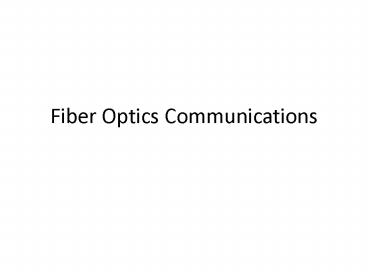Fiber Optics Communications - PowerPoint PPT Presentation
1 / 20
Title:
Fiber Optics Communications
Description:
Fiber Optics Communications * * Topics Fiber Materials Fiber Manufactoring Fiber Materials Requirements for optical fiber material It must be possible to make long ... – PowerPoint PPT presentation
Number of Views:1043
Avg rating:3.0/5.0
Title: Fiber Optics Communications
1
Fiber Optics Communications
2
Topics
- Fiber Materials
- Fiber Manufactoring
3
Fiber Materials
- Requirements for optical fiber material
- It must be possible to make long thin, flexible
fibers from the material - Material must be transparent at a particular
optical wave length in order for fiber to guide
light efficiently - Physically compatible materials that have
slightly different refractive indices for core
and cladding must be available
4
Fiber Materials
- Materials that satisfy these requirements are
glasses and plastic - Majority of fibers are made of glass consisting
of either silica or silicate. - Plastic fibers are less widely used because of
their higher attenuation - Plastic fibers are used for short distance
applications (several hundred meters) and abusive
environments
5
Glass Fiber
- Glass is made by fusing mixture of metal oxides,
sulfides, or selenides. The resulting material is
a randomly connected molecular network rather a
well defined structure as found in crystalline
materials - A consequence of this random order is glass does
not have a well defined melting point - When glass is heated , it gradually begins to
soften until it becomes a viscous liquid
6
Glass Fiber
- Optical fiber are made from oxide glasses and
most popular is silica (SiO2) which has
refractive index of 1.458 at 850 nm. - To produce two similar materials with slightly
different refraction indices for core and
cladding, either fluorine or other oxides
(dopants) are added to silica
7
Glass Fiber
- Sand is the principle raw material for silica
- Glass composed of pure silica is referred to as
either silica glass, fused glass, or vitreous
silica. - Desired properties are
- resistance to deformation at temperatures as high
as 1000 C - High resistance to breakage from thermal shock
- Good chemical durability
- High transparency in both visible and infrared
regions of interest
8
Plastic Optical Fibers
- Growing demand for delivering high-speed services
to workstations - Have greater optical signal attenuations than
glass fiber - They tough and durable
- Core diameter is 10-20 times larger
9
Fiber Fabrication
- Two basic techniques
- Vapor-phase oxidation process
- Outside vapor phase oxidation
- Vapor phase axial deposition
- Modified chemical vapor deposition
- Direct-melt methods
10
Fiber Fabrication
- Direct melt method
- Follows traditional glass making procedures
- Optical fiber are made directly from molten state
of purified components of silicate glass - Vapor phase oxidation
- Highly pure vapors of metal galides (SiCl4) react
with oxygen to form white powder of SiO2
particles - Particles are collected on surface of bulk glass
by above methods and are transformed to a
homogenous glass by heating without melting to
form a clear glass rod or tube. This rod is
called preform - Preform is 10-25 mm in diameter and 60-120 cm
long.
11
(No Transcript)
12
Fabrication
- Prefrom is fed into circular heater called
drawing furnace. - Preform end is softened to the point where it can
be drawn into a very thin filament which becomes
optical fiber - The speed of the drum at the bottom of draw tower
determines how fast and in turn how thick the
fiber is - An elastic coating is applied to protect the fiber
13
Outside Vapor Phase Oxidation
- Core layer is deposited on a rotating ceramic rod
- Cladding is deposited on top of core layer
- Ceramic rod is slipped out (different thermal
expansion coefficient) - The tube is heated and mounted in a fiber drawing
tower and made into a fiber - The central hole collapses during this drawing
process
14
(No Transcript)
15
Vapor Phase Axial Deposition
- Similar to outside vapor deposition
- Starts with a seed which is a pure silica rod
- The preform is grown in the axial direction by
moving rod upward - Rod is also rotated to maintain cylindrical
symmetery - As preform moves upward it is transformed into a
solid transparent rod preform by zone melting
(heating in a narrow localized zone) - Advantages
- No central hole
16
(No Transcript)
17
Modified Chemical Vapor Deposition
- Pioneered at Bell Labs, and adopted to produce
low loss graded index fiber - Glass vapor particles, arising from reaction of
constituent metal halide gasses and oxygen flow
through inside of revolving silica tube - As SiO2 particles are deposited, they are
sintered to a clear glass layer by an oxyhydrogen
torch which travels back and forth - When desired thickness of glass have been
deposited, vapor flow is shut off - Tube is heated strongly to cause it to collapse
into a solid rod prefrom - Fiber drawn from this prefrom rod will have a
core that consists of vapor deposited material
and a cladding that consists of original silica
tube.
18
(No Transcript)
19
Double Crucible Method
- Silica and halide glass fiber can all be made
using a direct-melt double crucible technique - Glass rods for the core and cladding materials
are first made separately by melting mixtures of
purified powders - These rods are then used as feedstock for each of
two concentric crucibles - Advantage of this method is being a continuous
process - Careful attention must be paid to avoid
contaminants during metling
20
(No Transcript)































